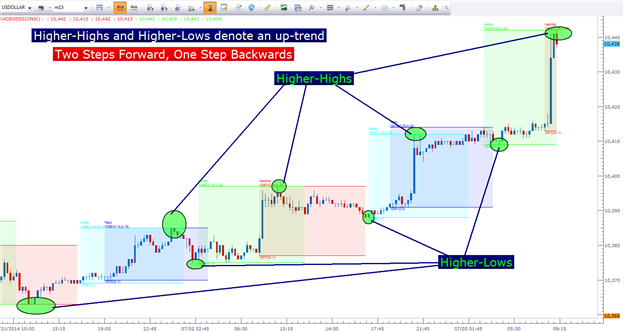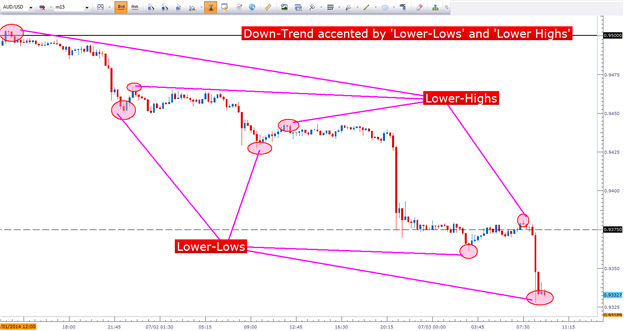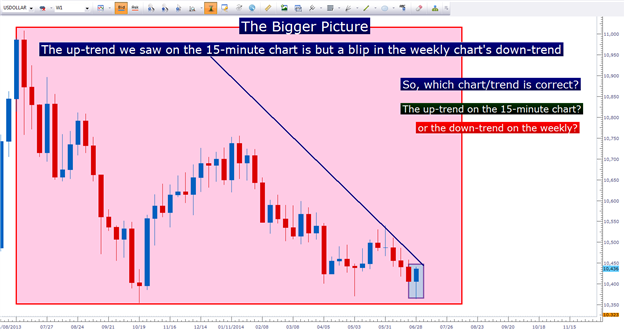Price Action in the Forex Market: How to Trade
by
, 07-11-2014 at 05:52 AM (1332 Views)
Talking Points:
- Price action is the study of price movements in a market.
- Many traders look at and use price action because it’s the cleanest view of technical analysis in a market.
- In this article, we discuss the most basic relationship at the center of price action: Supply and Demand.
One of the most difficult aspects of learning to trade is finding which systems, strategies, or indicators might work best given your personal goals in the market. Surely, there are quite a few choices out there and there are numerous different ways of going about speculation in a market; making this ‘journey’ to find a personalized approach even more difficult.
Further exacerbating this issue is the topic of ‘lag,’ or the fact that any technical indicator that is used (or any strategy based around technical indicators) will be delayed in its responses. The reason for this is simple: To create an indicator, a series of past prices are used to compute its values which create a type of ‘averaging’ effect. This can be good in the fact that it can help to smooth out volatile events (after all, this is why people use moving averages in the first place), but it can be bad because this averaging effect (whether it’s with a moving average or RSI) introduces delays and lag to the trader.
This is where price action can help. Price action is the study of price and price alone in a market, with no indicators required. With price action, traders can look to grade trends and market conditions, enter and trigger positions, and manage the risk of their trading operations.
In this article, we’re going to examine the most basic premise that allows price action to work: Supply and Demand.
The Most Basic Relationship in Markets: Supply and Demand
One of the best aspects of price action is that it offers traders a clean depiction of supply and demand at any one point in a market. As mentioned above, the lag introduced by indicators can create dissonance in a number of ways, least of which is allowing this ‘averaging’ effect to obscure the relevancy of near-term price movements.
Here’s an example: Imagine that we go into a Non-Farm Payrolls report and the USDJPY has been stuck in a tight trading range for the past 5 months. So moving averages on the daily, and the weekly chart are both moving flat to reflect this lack of vertical movement on the chart. But when NFP is released, we receive a ‘blow out’ figure that far eclipses even the most bullish analyst expectations.
Once NFP is released and prices spike, do we still take into account the relevancy of the moving average values? Because surely the periods used in the calculation of that moving average before the NFP print are quite a bit less relevant than the periods since, given that there is now new information that can create additional supply or demand (and thereby create additional price movements).
Supply and demand is at the core of price action.
If there is more demand than supply – prices will go up. This isn’t just FX or financial markets or commodities: This is all-around us in the world we live in.
Those Rolling Stone Tickets? Ya, they’re sold out at the box office so you have to pay exorbitant prices on Stubhub. (Demand has outstripped supply so prices go up as sellers can command a premium)
And Rolling Stones ticket prices can be charted just like this hourly chart on USDJPY:
Relating Supply and Demand to Trend Identification
But it takes a lot more than just one instance of higher prices to denote a trend, right? Otherwise, we’re seeing an anomaly that may be irrelevant to our goals of analyzing a market. So we have to look at each of these price movements with relative scope.
For a trend to take place, we need progressively higher (or lower) prices to continue for a prolonged period of time. Once we zoom out on the chart to see what this price spike means relative to previous price movements, we can get a significantly better view of what’s taking place in that market:
Higher-highs and higher-lows highlight up-trend in the US Dollar 15-minute chart
In the chart above, we take a look at an up-trend and as you can see, the market made progressively higher-highs and lower-lows over a prolonged period of time. We can reverse this relationship to investigate down-trends:
Lower-lows and lower-highs accent down-trend in AUDUSD
As you can see from the above charts, trend identification with price action is relatively simple, and maybe more importantly than that, it makes sense. Indicators can have a tendency to obscure the trend given the lag or disconnect involved, making them somewhat esoteric for many trader’s purposes.
But a bigger question must be asked; and this is applicable to not just price action but Technical Analysis in general: Which time frame is best for grading the trend?
As an example – if you look back to the second chart in this article, the US Dollar 15-minute chart, you’ll notice that the up-trend seems fairly robust. Higher-highs and higher-lows show prices tearing away on the 15-minute chart, but if you backed out to the weekly chart, you’ll notice a significantly different picture:
This is the conundrum of time frames, and brings up the old saying ‘if you want to find a trend, just change the time frame.
But which of these is the correct trend? And more importantly, which ones should traders follow? Think about these questions in scope of your personal approach, because there isn’t one ‘right’ answer here.
There’s somewhat of a sweet-spot here: If your time frames are too far apart, then price action may feel disconnected between the trend and entry charts; if they’re too close together than you’ll lose some of the benefit of the analysis.
In the article we proposed that traders should look for a ratio between 1:4 and 1:6 between time frames, as shown in the table below.
This would mean that if you’re looking to enter trades on the hourly chart, you can use the 4-hour chart to see the bigger picture trend. If you’re using the daily chart to enter positions, you can look to the weekly for trend analysis.
--- Written by James Stanley
More...

















 Email Blog Entry
Email Blog Entry